Beginning in the summer of 2002, Paul A. Shackel, Director
of the Center for
Heritage Resource Studies, began a long-term project to locate,
document, and study the growth and eventual demise of a town once
known as New Philadelphia,
Illinois. The story of New Philadelphia is compelling and nationally
significant: it is the earliest known town founded and registered
in a state by an African American in the antebellum United States.
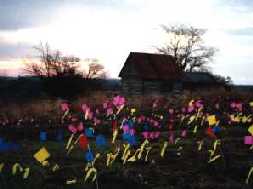
New Philadelphia is a nationally significant site that adds to our understanding of racism during the antebellum era. The goal of this interdisciplinary project is to make the story of New Philadelphia part of the national public memory.
This program is a cooperative project between the University of Maryland, University of Illinois, Urbana Champaign, Illinois State Museum, the New Philadelphia Association, and the University of Central Florida. The project was initiated and is also supported by the New Philadelphia Association. Members of the New Philadelphia Association and members of the community have been instrumental in furnishing logistical support for the project.
In 2005, Michele Huttes, a graduate student at the University of Illinois – Springfield, wrote the nomination that placed the town site of New Philadelphia on the National Register of Historic Places. The archaeological survey provided enough information to make a case that the resources are significant and can help answer important questions about life on the western frontier. In 2008, Charlotte King, a graduate of the University of Maryland, along with members of the New Philadelphia Association and Patricia McWorter as spokesperson for her family, presented their case to list the town site as a National Historic Landmark. In January 2009, the Secretary of the Interior listed the town site as a National Historic Landmark because of its archaeological significance and its potential to answer questions related to race on the western frontier. Currently, the Archaeological Conservancy is working with the New Philadelphia Association to purchase and preserve the most significant archaeological portions of the site.
There is now a lesson plan related to some of the research related
to New Philadelphia titled New Philadelphia: A Multiracial Town on
the Illinois Frontier (http://www.nps.gov/history/NR/twhp/wwwlps/lessons/130newphila/index.htm).
Written by Charlotte King for the Teaching with Historic Places program
in the National Park Service, provides and history and a set of questions
related to the development of the town.
Please scroll down to read more about the project. For additional information about current research at the site follow the links to the right and below, or consult New Philadelphia FAQ's
The Making of New Philadelphia
The story of New Philadelphia begins with Frank McWorter, an African American who hired out his own time and established his own saltpeter mining operations while enslaved in Kentucky. With the money he earned he purchased his freedom, and in 1836 McWorter acquired lands in a sparsely populated area known as Pike Country, Illinois, situated in the rolling hill region between the Illinois and Mississippi Rivers. He had the town professionally surveyed and registered it with the state of Illinois. He then subdivided it and sold lots. McWorter used the revenue from these sales to purchase the freedom of family members.
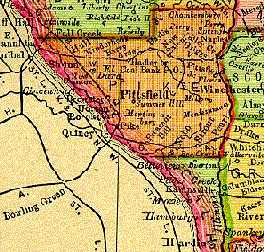 Both
whites and blacks purchased property in New Philadelphia and the town
existed as an integrated community well into the twentieth century.
New Philadelphia stood 20 miles from the Mississippi River where the
slave trade prospered and the McWorters and other black members of
the community were always under the threat of being kidnapped and
sold “down river.”
McWorter’s activities as town founder, proprietor, promoter,
and developer foreshadowed the direction that other African Americans
would take on the nation’s frontiers after the American Civil
War.
Both
whites and blacks purchased property in New Philadelphia and the town
existed as an integrated community well into the twentieth century.
New Philadelphia stood 20 miles from the Mississippi River where the
slave trade prospered and the McWorters and other black members of
the community were always under the threat of being kidnapped and
sold “down river.”
McWorter’s activities as town founder, proprietor, promoter,
and developer foreshadowed the direction that other African Americans
would take on the nation’s frontiers after the American Civil
War.
After the Illinois frontier closed, racism set limits to New Philadelphia expansion. County planners lobbied to have the railroad routed adjacent to another community. By the 1880s the town was unincorporated, and by the early twentieth century only a few houses survived. Today, all signs of the town have been removed from the landscape and the fields are planted in prairie grass and wheat.
Archaeological and Historic Research at New Philadelphia
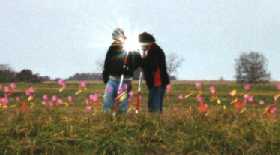 During
three long weekends in October and November (2002) and March (2003)
Dr. Shackel led an archaeology survey team to located New Philadelphia.
The survey team included UM graduates Cheryl LaRoche, Robin Whitt, Joy
Beasley, and Tom Gwaltney (HistArc). Terrance Martin (ISM) and
Lynn Fisher (UI-S) coordinated the field effort that included volunteers
from the Illinois State Museum, Illinois College, Hannibal-LaGrange
College, UI-S, Lincoln Land Community College, and the New Philadelphia
Association. The project was initiated and is also supported by
the New Philadelphia Association with Mr. Philip Bradshaw as its president.
During
three long weekends in October and November (2002) and March (2003)
Dr. Shackel led an archaeology survey team to located New Philadelphia.
The survey team included UM graduates Cheryl LaRoche, Robin Whitt, Joy
Beasley, and Tom Gwaltney (HistArc). Terrance Martin (ISM) and
Lynn Fisher (UI-S) coordinated the field effort that included volunteers
from the Illinois State Museum, Illinois College, Hannibal-LaGrange
College, UI-S, Lincoln Land Community College, and the New Philadelphia
Association. The project was initiated and is also supported by
the New Philadelphia Association with Mr. Philip Bradshaw as its president.
Without any visible signs of preexisting landscape features the research team used historic and topographic maps and aerial photographs to determine the general location of the town. Local farmers plowed the fields and the archaeological survey consisted of a systematic walkover of original 42-acre town. The archaeology team located pieces of ceramic, window glass and nails in discrete concentrations that indicate the location and remains of domestic houses and commercial enterprises. All of the archaeologically documented sites appear to cluster around the town’s known commercial district.
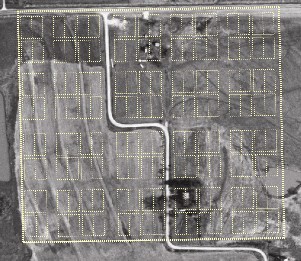 |
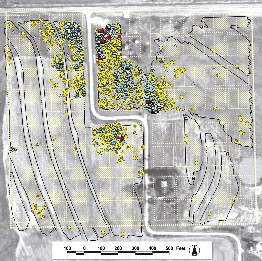 |
Plat lines of
historic New Philadelphia superimposed over the modern landscape. |
Plot of the locations
of domestic artifacts recovered |
Terrance Martin (ISM) is directing volunteers who have logged about 350 hours cleaning, labeling, and rebagging the artifacts from the survey. After being processed at ISM the artifacts will be catalogued in the spring of 2004.
One of the current caretakers of the property, the New Philadelphia Land Trust, also sees the importance of preserving and studying the property. This group, along with the research team, believes the story of New Philadelphia is unique because it is about the personal struggle of an African American to exist in a racist society while incorporating and settling in an integrated town on the western frontier. They hope that one day the story of New Philadelphia will become part of the national story by designating it a state or a national park.
For more information on Frank McWorter, see:
| Walker Juliet E.K. | |
|
1983 (reprinted 1995) |
Free Frank: A Black Pioneer on the Antebellum Frontier. University of Kentucky, Lexington, KY. |
Some of this material is based upon work supported by the National Science Foundation under Grant #0353550. Any opinions, findings and conclusions or recomendations expressed in this material are those of the author(s) and do not necessarily reflect the views of the National Science Foundation
|
Research Reports
|
| Recent Research on New Philadelphia
|
Organizations and People Working to Rediscover New Philadelphia |
| Participants in Initial Archaeological Survey* |
New Philadelphia Association
|
Volunteers(from Illinois State Museum, Illinois State Historic Preservation Office and local volunteers and students from Hannibal LaGrange College, Illinois College, University of Illinois-Springfield, and Lincoln Land Community College) Heather Bangert |
* For lists of additional participants in the New Philadelphia Project please consult the 2004 and 2005 Archaeology Reports

